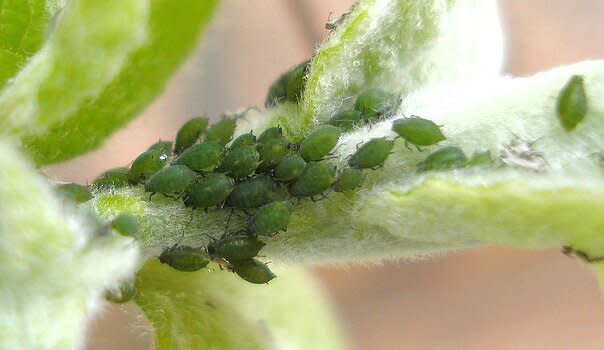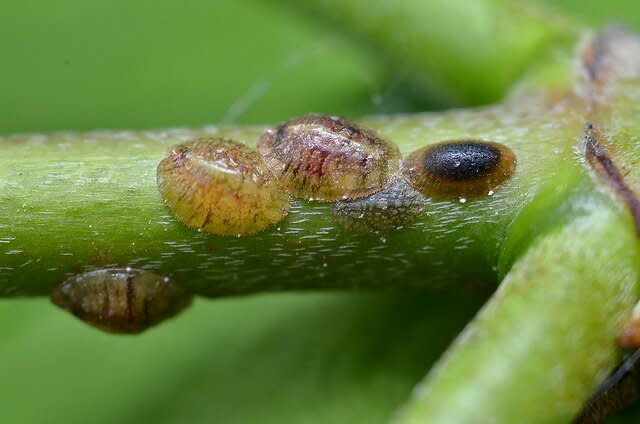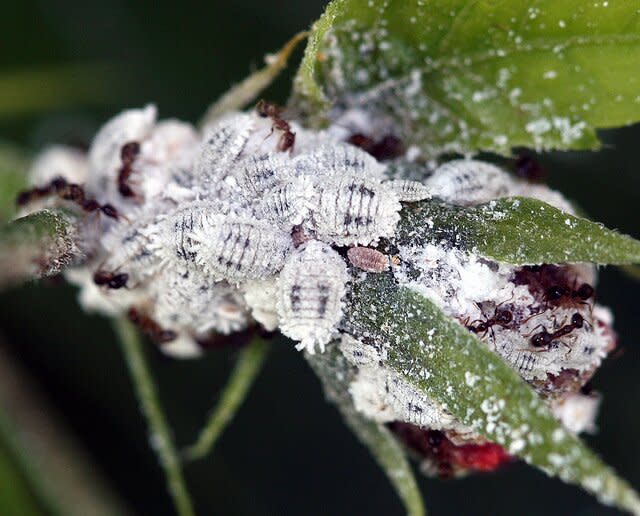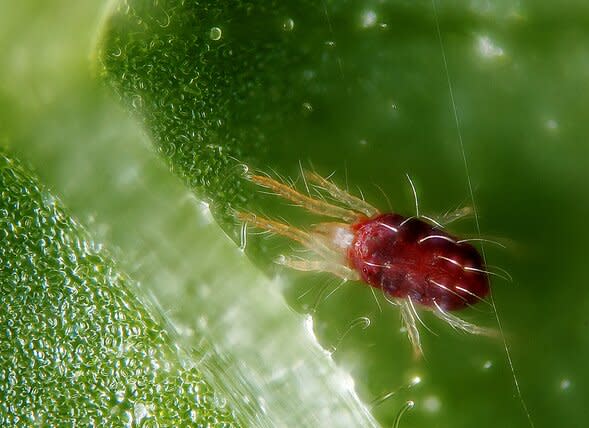4 Bad Bugs to Watch for This Winter

Aphids. These little suckers can be green, yellow, red, orange, gray, or brown. Photo by Nick E. Talbot.
Just because it's cold and miserable outside doesn't mean bugs are miserable too. Some live quite warm and happily inside your home during the winter, feasting on your indoor plants. Here's a helpful roundup of four of the most common bugs, how to identify them and the damage they do, and how to kill them dead, dead, dead. And dead.
Houseplant Enemy #1 — Aphids. These plump, little guys (above) are easy to spot because they huddle together like seals on a beach. Green ones are common, but they can just as easily be yellow, orange, red, or brown. They favor tender, young foliage and often congregate on flower buds and branch tips, although you can also find them on stems and the undersides of leaves.
Damage. Aphids suck the sap from plants and secrete a sweet honeydew ants like to eat. If you find aphids on your houseplants, don't be surprised if ants carried them there. Aphids multiply incredibly fast. They cause leaves to pucker, distort, and fall off. Infested flower buds shrivel and drop.
Control. Not hard if you spot the aphids early. Pick off and throw away infested flower buds and branch tips. Spray the plant according to label directions with either of two very safe, natural controls — all-season horticultural oil or insecticidal soap. Or save the money and make your own insecticidal soap. Just fill a quart spray bottle with water and about 4-5 drops of liquid detergent. Shake and then spray. It'll kill the aphids almost instantly. So satisfying!

emArmored scales look like little bumps on stems and leaves. Photo by entophile./em
Houseplant Enemy #2 — Armored Scales. Brown, gray, or white, these weird bugs (above) get their name from how they feed on plants. Young insects crawl onto a plant they like, insert sucking mouthparts into the leaf or stem, drop off their legs, and build hard shells atop themselves for protection. The scales remain in place until eggs inside the shells hatch and the adults die. Regular contact pesticides don't work on them, because they can't penetrate the shell.
Damage. Depending on the type of armored scale, it can encrust entire leaves, stems, and branches. The result is yellowing leaves, dying branches, and a declining plant.
Control. Inspect your houseplant carefully. If you find only a few scales, scratch them off — they can't crawl back. If there are lots, spray with horticultural oil. Be sure to wet all leaf and stem surfaces. The oil will smother the scales.

emMealybugs form cottony, white masses on plants. Yuck! Photo by Giles San Martin./em
Houseplant Enemy #3 — Mealybugs. Mealybugs (above) are soft scales that differ from armored ones because they don't build hard shells and can also crawl around. They're easy to spot because of their white, cottony exoskeletons. They suck sap and secrete honeydew.
Damage. An infestation of mealybugs can literally suck the life out of a plant. Because mealybugs are mobile and multiply with breakneck speed, they quickly spread from one plant to another. Grumpy hates mealybugs!
Control. Catch the infestation early! Kill individual mealybugs by dabbing them with a cotton swab soaked in rubbing alcohol. If you see lots, spray with horticultural oil or insecticidal soap. Be advised that mealybugs can crawl into the smallest crevices between stems and leaves, making saving heavily infested plants nearly impossible. You're better off throwing the poor plants away.

emRed spider mites are seldom lonely. They have thousands of mite buddies. Photo by Giles San Martin./em
Houseplant Enemy #4 — Spider mites. Spider mites aren't really bugs or insects. They're tiny arachnids related to spiders about as big as a sharp pencil point. Like aphids and scales, they suck sap from leaves and stems and reproduce like crazed bunnies. Spider mites come in as many different colors as aphids. They congregate on branch tips and leaf undersides, often wrapping leaves and stems with very fine webs. If you see webs, your plants are in trouble.
Damage. The first damage you'll probably notice is speckling or bronzing of the foliage. As the problem worsens, leaves or needles yellow, brown, shrivel, dry, and drop. Flower buds wither. Branches die back. Severe infestations kill.
Control. Like most people, mites hate humidity. They reproduce rapidly in dry, heated air — like the kind that's inside your house in winter. You can greatly deter spider mites simply by misting your plants several times a day to raise the humidity. To save infested plants, spray all plant surfaces with horticultural oil or insecticidal soap. You'll likely have to do this more than once. These products smother both mites and their eggs. Or blast off the mites with a jet of lukewarm water.

